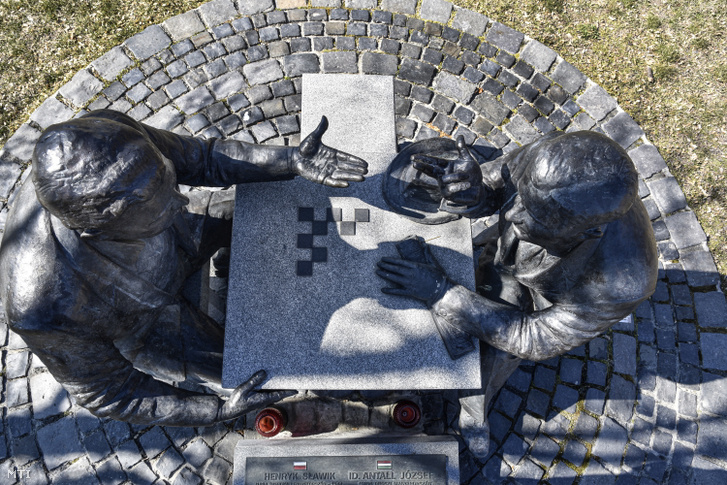On the occasion of the International Holocaust Remembrance Day, we recall the life and work of the Polish Henryk Sławik.
Poland and Hungary cherish the memory of many saints and heroes who played a decisive role in the history of the two countries. Among them is Henryk Sławik, the Polish politician and journalist who Together with József Antall, he saved many lives during World War II. during World War II.
Henryk Sławik was born in 1894 in the town of Szeroka in Silesia, which at that time still belonged to the German Empire under the name Timmendorf. After graduating from the local Volksschule (a combination of elementary school and lower secondary school in the old Prussian education system), he worked on a farm and then lived in the predominantly working-class district of Hamburg called Altona, where in 1912 he joined the PPS (Polish Socialist Party).
In World War I, he fought in the Imperial German Army as an enlisted soldier on the Eastern Front, where he was captured by the Russians and deported to Siberia.
After the revolutions in Russia, he returned home to the reborn Poland, where he participated in the third Silesian uprising against German rule (May 2 - July 5, 1921), and then settled in Katowice at the age of 20. In the city famous for its mining, he worked as a social democratic journalist as the editor of Gazeta Robotnicza (Workers' Newspaper). In 1928, he married Jadwiga Purzycka, with whom he had a daughter, Krystyna, two years later. He was also a PPS representative in the Katowice City Council for a while.
Sławik in Hungary
The II. At the beginning of World War II, Poland was the first to fall victim to the aggression of Nazi Germany, which was still allied at the time, and the Soviet Union, which was attacking the Polish troops retreating in the east (in addition, the forces of Jozef Tiso's Slovakia joined Germany, but Governor Miklós Horthy and Prime Minister Pál Teleki together with the members of the Hungarian State Council refused fulfilling the Nazis' request).
Hungary and Romania opened their borders to the fleeing Poles, which is how Henryk Sławik came to our country.
From September 1939, around 150,000 Polish soldiers and civilians arrived in Hungary (due to the annexation of Subcarpathia in 1939, there was a common Polish-Hungarian border from March to September). The leaders of the Hungarian state and the population passed the test of solidarity towards the refugees of the friendly nation. Poles arriving in Hungary from September 17 were welcomed with "Witamy" (roughly "Welcome to God!") signs.
At the end of 1939, the EWA operation began, which prepared the smuggling of Polish soldiers and Polish refugee men of conscription age towards Yugoslavia and Greece. By 1940, roughly 110,000 Poles had left Hungary, most of them fled to France, and later to Great Britain and French-ruled Syria, where they organized military units.
Sławik also thought in similar ways, until he met id. With József Antall in Miskolc. The politician of the right-wing FKgP, who was the refugee commissioner of the Ministry of the Interior, quickly became friends with the left-wing Polish journalist.
In October 1940, the Hungarian-Polish Asylum Committee, or in some sources simply the Civil Committee (Komitet Obywatelski do Spraw Opieki nad Polskimi Uchodźcami na Węgrzech, in short: Komitet Obywatelski), was established, with Sławik as its leader. Antall the Elder very seriously helped Sławik's work and turned a blind eye to certain violations of the law (e.g. forging documents for Polish soldiers who wanted to escape from Hungary and then joined the British army, as well as Polish Jewish refugees), due to which Nazi Germany and its Hungarian his collaborators were resentful.
Sławik's cultural work deserves a separate paragraph: he joined the Hungarian Mickiewicz Society (Adam Mickiewicz is the most popular 19th-century romantic poet and writer of the Poles), within the framework of which he organized cultural events. He also took part in the publication of the Polish-language newspaper Wieści Polskie (Polish News), which appeared in Hungary between November 2, 1939 and March 24, 1944, and this paper also reached abroad (even to the Polish communities of countries under German occupation).
One of the most important parts of his life's work was the establishment of the House of Polish Officer Orphans in Vácott.
The ID. Franciszek Świder, a Polish teacher and scout, was at the head of the institution, created with the cooperation of József Antall. The theoretically Roman Catholic institution, which received the building of the Hirschfeld Girls' Boarding School located at 11-13 Althann Street (nowadays the property no longer stands), in reality housed Polish Jewish refugee orphans, 35 boys and 30 girls.
The German occupation of Hungary on March 18-19, 1944 ended the work of József Antall Id. and Henryk Sławik. Sławik was arrested and then deported to the Mauthausen-Gusen concentration camp, where he was murdered on August 25 or 26, 1944.
Słavik's memory
The state socialist dictatorship after 1945 did not embrace the memory of Sławik in Poland. In 1977, he was posthumously awarded the World's Right Israeli state award. Research on his biography began in the 1990s, in Hungary the works of Károly Kapronczay and István Lagzi represented a breakthrough. Grzegorz Łubczyk wrote a monograph about Sławik's life, which was published in Hungarian under the title "The Forgotten Hero of Three Nations: Henryk Sławik" in 2009. It includes many primary sources (pictures and written documents), as well as the thoughts of his daughter Krystyna and former Jewish orphans.
Hungarian political life began to take an interest in Sławik from the 2000s. One of the most significant events is when, on September 24, 2014, the Parliament tabled Bill H/1270 entitled "In memory of the 70th anniversary of the death of Henryk Sławik and the 40th anniversary of the death of József Antall Sr." adopted resolution proposal no. with 179 yes votes, no dissenting votes, and 1 abstention. After that, they erected a memorial to him in public squares.
Henryk Sławik and id. is located on Goldmann György tér in Budapest. The statue of József Antall, which was inaugurated in 2017 by the President of the National Assembly and the then President of the Polish Parliament.
(A similar monument can be found in the city center of Warsaw on Fryderyk Chopin Street, not far from the famous Fürdő Park.) Since 2015, the stretch of coast between the Kopaszi Dam and the Petőfi Bridge has been named Henryk Sławik Quay in recognition of the Polish hero's work. Gymnasiums were named after him in Katowice and Jastrzębie-Zdrój, and many streets in Silesian settlements were named after him.
This summer will be the 80th anniversary of Sławik's death. The Polish hero's gratitude to the Hungarians is best summed up in the article published in the May 12, 1943 issue of Wieści Polskie:
"When our feet touch the holy land of our native land again, many of us will look back at the hospitable Hungarian land, which so cordially drew us in and nourished us for so many years. We will then understand that it is not a foreign land, but that of our loyal friends, who did not deny us during the difficult and troublesome hours, but helped us overcome the most difficult period of our spiritual and physical shelter with a noble courage worthy of them."
László Pálfi is an external researcher at Instytut Pileckiego
Featured image: The statue of Henryk Slawik and József Antall the Elder in the capital's XI. district, on Goldmann György tér / Photo: László Róka / MTI












